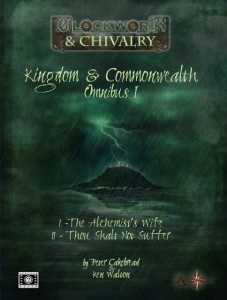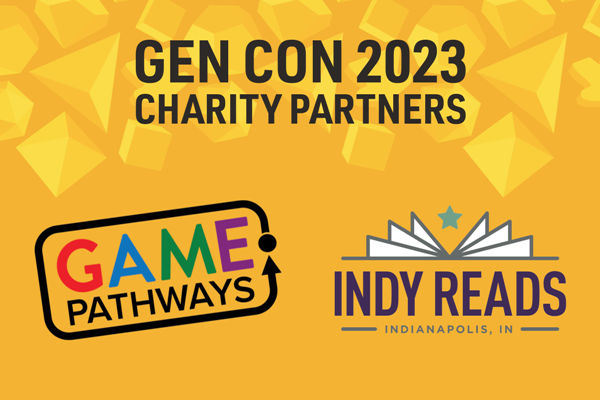Clockwork & Chivalry Part 4: Game Balance
By Aaron T. Huss

Learn more about the Kingdom & Commonwealth campaign here
Welcome to part 4 of the Featured Product series for Clockwork & Chivalry, published by Cakebread & Walton. Part 4, Game Balance, takes a look at actual game play and how the mechanics and setting are designed and balanced.
GAME MECHANICS
All tabletop role-playing games have mechanics. Whether they are dice-, narrative-, or trait-focused, role-playing games wouldn’t exist without these mechanics, even if they are merely guidelines. Without mechanics, you’re just playing pretend and anyone has the final say on who’s right and who’s wrong. When you delve into those game mechanics, there’s always something that balances the system out or at least swings things into the direction of the player characters. For the Renaissance system, those balancing game mechanics are Dodge / Parry and Hero Points.
Renaissance, and its d100 family, contains deadly combat with great opportunities to shine as a hero. Weapons and armor seem much more realistic, as opposed to epic fantasy systems, and your attacks can easily one-hit kill an opponent. Additionally, the foes you face may have natural armor or protection that make combat that much more difficult. So how do you keep the PCs alive in these deadly fights? By making your Dodge and Parry rolls or using Hero Points when you really need to save your bacon!
I took The New Mission team (as described in Part 3) through two missions. The first mission was a Clockwork & Cthulhu mission to get the full horror feel. The second mission was from Clockwork & Chivalry to get the basic feel of the setting. One thing to keep in mind is that the group template constructed for this team was designed to investigate and overcome the Cthulhu Mythos through a balanced selection of investigation and defense. It was not a team of fighters nor was it a team of amazing alchemists. The team was definitely designed with investigative horror in mind. That might have been a mistake…
When you read through the Clockwork & Chivalry setting and more importantly the Renaissance system, you will find that combat does not necessarily favor the PCs. Melee weapons are quite standard and easy to wield, but there are no magic or relic weapons to be found. Ranged weapons do more damage, but are cumbersome and take time to reload. In fact, if you plan on shooting that black powder gun often during combat, you’re sadly mistaken. These guns are meant to be fired once, maybe twice in combat because reload times are 2 – 4 rounds long. Now, before you grumble about not being able to fire your Flintlock rifle each round, you have to remember the setting being represented by the system, because that’s reality. Black powder weapons are meant for continuous action. A better idea would be to prep them before combat so that you can get a really good shot in. Use it is a club until that point presents itself and the BAM! Do the amount of damage necessary to swing the combat your way. However, don’t expect to win every encounter with these weapons.
So what options do you have? If a couple PCs can brandish a black powder weapon, that may come in handy to save the day from an attack by a “really big bad.” When it comes to all the standard creatures, you’re better of relying on the characters’ ability to find with melee weapons, bows, crossbows, alchemy, or maybe a clockwork weapon. This means combat will very often be “in-your-face” with plenty of deadliness. However, and I would like to stress this, this style of combat mechanics makes the game that much more exciting and truly brings out the horror of the setting and how frightening it can be to come into contact with a fantastic creature. Death is a real concern!
Don’t fret, though, as you do have your game balancing (or rather unbalancing) specialties that can help your PCs out. Don’t forget to make those Dodge and Parry checks, and don’t forget you can use those Hero Points. You may think that armor will simply save your characters, but as a setting with realistic characteristics, armor is expensive and most characters cannot afford much. It is safe to say that intelligence on the battlefield (including tactics) is as important to Renaissance as it is in real-life. In real-life, soldiers do not grab their swords and rush in to meet their foe, they use tactics and special training to best their foe without getting injured. This is the style of combat inherent to this d100 family of RPGs.
So what about the damage you deal? Well, it’s not very much unless you are using the right weapons. If combat damage is a concern, make sure you create characters that are “large” enough to have a Damage Modifier in the positive direction to give their attacks more “oomph” and make sure their skills are good enough to land plenty of those attacks. Don’t be afraid of combat, just be properly prepared. My New Mission team, however, was not meant to be a combat team and had to use their wits to survive. One thing I found particularly difficult was overcoming a foe with a medium armor rating when the PCs had very light or light at best. When dealing only 4 points of damage, 3 armor points becomes quite the feat to overcome. This is one thing to consider when outfitting your PCs with equipment and assembling a group template. But then, you also have consider that weapons have a Strength and Dexterity requirement. The whole process becomes a balancing act, which is prevalent throughout many RPGs, especially those where combat is seen as deadly and not epic (with the former being more realistic).
SURVIVABILITY
My team did not fair too well. One of the encounters in the Clockwork & Cthulhu game saw the PCs encountering a large pack of wolves and a surprise leader. Unfortunately, the PCs were not designed for combat and ultimately all died. With a bit of backpedaling and fleeing, they survived the fight and ran far from the pack. To me, the encounter seemed way too deadly for a Cthulhu investigative group and would have done better with a group prepared for combat. This was not part of my group template and resulted in failure. I’m not sure if the fault was the balance of the encounter, or the group template. Either way, the encounter seemed very unbalanced for a Cthulhu Mythos encounter occurring very early in the investigation.
When the group was ported over to Clockwork & Chivalry, they had a much easier time. To me, Clockwork & Chivalry is about more than the physical conflict happening in the setting, but also the political and social conflicts that occur between clashing factions and the two sides of the civil war vying for power. A group such as The New Mission would probably do quite well in the Kingdom & Commonwealth campaign as it brings them across the land in all sorts of stories revolving around a central theme (I won’t spoil it!). Clockwork & Cthulhu seems less like a campaign setting, although it should be possible given the overall setting and how the GM can mix the Cthulhu Mythos with the standard Clockwork & Chivalry setting, making many interesting stops along your way!
From an overall survivability standpoint, keeping a close eye on those game-swinging mechanics is probably the best way to go. You don’t need to “min-max” your characters, but you definitely need to create a group template that allows for long-term games, unless your trying to kill the characters in a Mythos-laden romp.
Clockwork & Cthulhu throws in another mechanic for gauging survivability in the form of sanity. I really found the Sanity mechanics to be worrisome as everyone of the PCs when insane (okay, maybe not all of them, but it sure seemed that way). Your PCs do not have a lot of Sanity points to begin with and the encounters in the core setting guide have a lot of negative modifiers to the Persistence roll. These modifiers caused a lot of loss to Sanity, resulting in a quick deterioration of Sanity Points (I was rolling quite high when it came to loss of Sanity Points). Before you go and think the horror is too much for the setting, The New Mission was pressing quickly through their investigation instead of stopping to rest and heal (which regains Sanity Points). It was a delve into the Mythos that probably should have been a slower delve, but watching them deteriorate mentally was kind of fun! Again, make sure you watch those Hero Points as they can save your mental bacon.
BALANCED OR UNBALANCED
I can’t really say one way or another if the overall Renaissance system is balanced or unbalanced. To me, the system is designed to represent the deadliness of combat and the inherent issues surrounding the use of black powder weapons. It avoids the epic fantasy tropes and still offers PC-saving mechanics to help swing things their direction. Yes the encounter with the wolves did not feel balanced (mainly due to their 3 armor points), but everything else felt good. Renaissance definitely makes you think about your in-game decisions as rushing-in like a fool could easily spell death.
I will say one thing about the mechanical balance – it’s a lot more fun when you’re not guaranteed epic survival as it forces you to play the game and not just skate through it.

